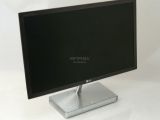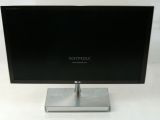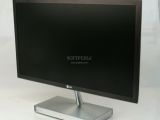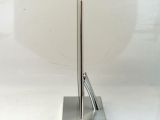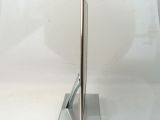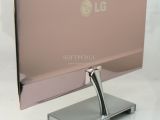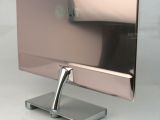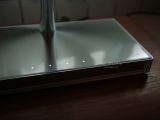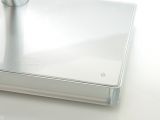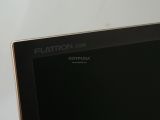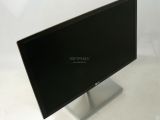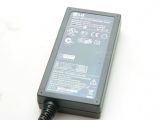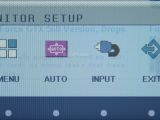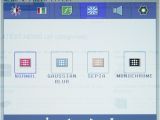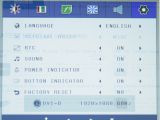For a while now, LCD manufacturers have tried to design and build the slimmest monitors possible and today we get to review one of the strongest contenders to this title, the LG Flatron E2290V 21.5-inch Full HD display which measures a meager 7.2mm.
LG says that it was able to reach such a thin profile thanks to its so-called EZ cabling technology that moved the video connectors from the monitor’s back to its base.
Actually, this is only one of the design decisions which LG had to take in order to make the monitor as thin as it is now, but the end result is really impressive.
As the Korean company explains, the E2290V is powered by a high-performance chip which reduced the number of IC’s that had to be installed to drive the monitor. LG isn’t too specific about this chip and settles to say that it “has the power of two chips in one.”
Unfortunately, we haven’t managed to find a way to dismantle the monitor without breaking it, so we will have to settle with LG’s explanation for now.
Other design decision that led to the development of such a thin monitor had to do with the power supply of the device, since this has been moved from inside the display chassis and into a standalone power brick.
Otherwise, the E2290V is pretty much your basic LED backlit monitor and packs all the energy saving features and specifications which are common to current monitors.
We will get into details later in this review, where we will also take a closer look at the monitor’s performance and image quality.
Aesthetics and design
The first thing one notices when getting the LG Flatron E2290V out of its box is how thin this monitor actually is, and I can assure you that the 7.2mm thick profile is actually even more impressive in person than in the specifications.
Getting past the initial shock, one starts to notice the elegant design that uses a metallic finish with rounded edges to add a dash of style to the E2290V.
The monitor is connected to a pretty large base via a silver foot that also features the same metallic finish as the display chassis.
As I mentioned earlier, the base is pretty much where all the magic happens as it hides some of the monitor's power circuitry as well as all the video inputs that are required for connecting the monitor to the PC.
This means that the base of the Flatron E2290V is noticeably larger than the base of other monitors, but LG has managed to keep the overall stylish aspect of the display in spite of this fact.
The base also provides very stable support for the monitor, thanks to its large footprint and added weight.
This is definitely a nice change when compared with most other present-day monitors, as most of them feel really wobbly when touched.
The only downside to the design, from a functional point of view, is the lack of more advanced monitor adjustment options as the monitor can only be tilted about 10 degrees backwards.
Controls As mentioned earlier, LG has moved most of the monitor's electronics to its base and this includes the touch sensitive control keys.
While I am not a big fan of these type of buttons, I can say that in the case of the E2290V, LG has managed to get things right as the keys only required a light touch to be activated.
However, what I didn't like was that the buttons weren't properly marked, so each time that a key needed to be pressed you had to take a look at the on-screen OSD to see what that specific touch button does.
In the seven days or so I had the E2290V at my disposal, I wasn't able to get to terms with this control scheme and I am sure that even if I had had more time, I still wouldn't be able to use it without looking back and forth at the OSD and control keys.
To make matters worse, the light that marks the touch sensitive keys only lights up when such a key is activated, so finding them in the dark is really a chore as one has to rely on pure luck.
In addition to the four touch-control keys, the E2290V also features a touch-activated power button which glows red when the monitor is turned off.
Fortunately, this is properly marked and is also easier to spot as LG has decided to super-size it when compared to the other touch keys.
Connectivity All the connectors that are available in the E2290V are installed in the back of the monitor's base.
This makes installation rather difficult as the monitor has to be turned with the back towards the user to see where everything has to go.
Furthermore, the distance between the actual ports and the edge of the base is significant, which means that plugging in the connectors can be a pretty fiddly job.
Moving from left to right, we see that the E2290V is equipped with an HDMI port, a DVI video input, a D-Sub connector as well as with a headphone out and DC in jacks.
Why LG decided to include a headphone out jack at the back of the base is beyond me, as this is really hard to reach, and I couldn't imagine anyone choosing this jack over the front panel audio connectors that come standard with almost any PC case and computer system.
In addition to the various I/O ports, the E2290V also packs a Kensington security slot.
Tech Specs
LG Flatron E22909V Specifications: Connectivity: DVI, VGA, HDMI Ergonomic options: 10-degree back tilt Resolution: 1,920x1,080 pixels Aspect ratio: 16:9 Audio Headphone jack: Yes VESA wall-mount support: No Included video cables: DVI, HDMI Backlight: LED Panel Type: TN Screen film: Matte Pixel-response rate: 2ms Number of presets: 3 Overdrive: No Picture options: Brightness, Contrast, Sharpness Color controls RGB controls: sRGB, 6500K, 7500K, 8500K, 9300K Gamma control: Yes Additional features: n/a
Dimension (W x D x H): 511.4 x 135 x 399.3 Weight: 2.8Kg
Stand: Tilt f-Engine: Yes Intelligent OSD: Yes DDC/CI: Yes Intelligent Auto (Auto Resolution): Yes
Real-life performance
Setup and general operation Before making our way to the image quality and operation of the E2290V, it’s important to note that the monitor is easy to set up as it comes assembled together with the base and all that the user is required to do in order to get started is to connect the external power brick and the video input cables to the base of the monitor.
The monitor will automatically detect the input source and switch to it once it is powered up.
Display and image quality The first thing that one notices when it powers the E2290V is that the monitor is extremely bright. LG has actually setup the brightness to 100 per cent, which causes the images displayed to get a somewhat milky appearance.
The incorrect factory settings also affect the overall quality of the image which appears to carry a strong blue tint.
This can be corrected by fiddling with the control options available in the OSD and some of the best results can be achieved by using the sRGB color temperature.
After some more tinkering around, we managed to adjust the image quality of the display to resemble that of some of the best TN panels we have tested, but the process is pretty time consuming and requires some basic knowledge about how every option affects the image displayed.
Even better results can be achieved by using a calibration profile and for our tests we relied on a MonacoOptix x-rite calibrator to get the image just right.
I am well aware that most of you won't have such a device on hand, but the final result is really worth it.
The horizontal viewing angles of the monitor were more than OK for a TN panel, but the E2290V severely lacks as far as its vertical viewing angles are concerned.
The last part of the display quality tests run were meant to see how the monitor performs when exposed to high-paced action sequences and games.
With a response time of just 2ms, the LG E2290V should perform really well in these tests, but the monitor could still hold some surprises as quite a few reports suggested LG shipped a few batches of these displays that had a 5ms response time.
Before anyone worries, I want to reassure you that the company has clearly marked all those models to properly reflect their correct response time.
Fortunately, this wasn't the case with our test unit as the display has managed to fare quite well in our test that involves running a scene from the 3DMark 03 graphics benchmark program and then taking a picture with a properly setup camera.
As you can certainly see, the ghosting is minimal and shouldn't pose any problems in games or action movies.
Finally, I can conclude that, as far as image quality is concerned, the E2290V behaves according to the effort put into adjusting its operation parameters, so I would advise anyone that buys this monitor to tune its image settings, as the default profile is less than stellar.
OSD (On-Screen Display) Before moving to the conclusions of this review, we will take a quick look at the OSD of the E2290V.
As mentioned earlier, its operation is a bit tricky as the four touch buttons found on the base aren't clearly marked and it takes quite some time to get used with what each one of these does.
Outside of these problem, the OSD packs quite an impressive amount of settings, including presets such as Internet, Cinema or Text.
These are accompanied by three special effects presets that can add a monochrome, sepia or gaussian blur effect to the images displayed.
Color temperature can also be changed between five presets: sRGB, 6500K, 7500K, 8500K, and 9300K.
The first one of these is best suited for this monitor, but don't be fooled by its name as the E2290V packs only a TN panel which isn't suited for tasks that require precise color values.
It did it so well in fact that it has set a new standard for display manufacturers that I doubt it will be surpassed in the not-so-distant future. And even if someone manages to build an even thinner monitor, I doubt that it would have much of an impact on the public as there's isn't much point in shaving a few fractions of a mm from a profile that already measures just 7.2mm. Having said that, however, the E2290V isn't for anyone as the $329.99 price tag is pretty hard to justify when taking a look at its performances or functionality.Conclusions
So, in the end, while this might be a great addition for a stylish reception area or for other environments where looks prevails over function, most other users will look elsewhere for getting a monitor.
Considering the high price tag there are more that just a few other options available and most will do a lot of things better than the Flatron E2290V.
The good: - attractive design - thin profile - extensive OSD menu - fast response time
The bad: - the high price - poor image quality out of the box - limited vertical viewing angles - TN panel
Sales package
- LG Flatron E2290V - power adapter (brick) and cable - DVI and VGA cable - user's manual.
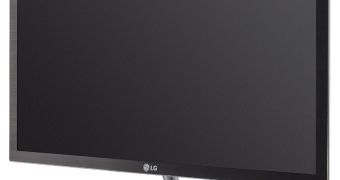
 14 DAY TRIAL //
14 DAY TRIAL // 
